Analysis of Global Economics: Why Nations Protect Industries Report
VerifiedAdded on 2023/06/07
|8
|1630
|123
Report
AI Summary
This report delves into the reasons why nations implement protectionist measures for their industries, examining the Labor Argument, Infant Industry Argument, National Security Argument, and Retaliation Argument. It explores how these arguments impact consumers and governments, differentiating between economic and non-economic justifications. The paper provides an overview of the arguments, analyzes the findings, and compares them with existing scholarly work. It concludes with recommendations, highlighting the importance of selecting appropriate protectionist strategies, and includes a quantitative analysis using supply and demand curves. The report also discusses the effects of tariffs, income distribution, resource allocation, and government revenue, providing a comprehensive understanding of the complex dynamics of global economics and trade protectionism.
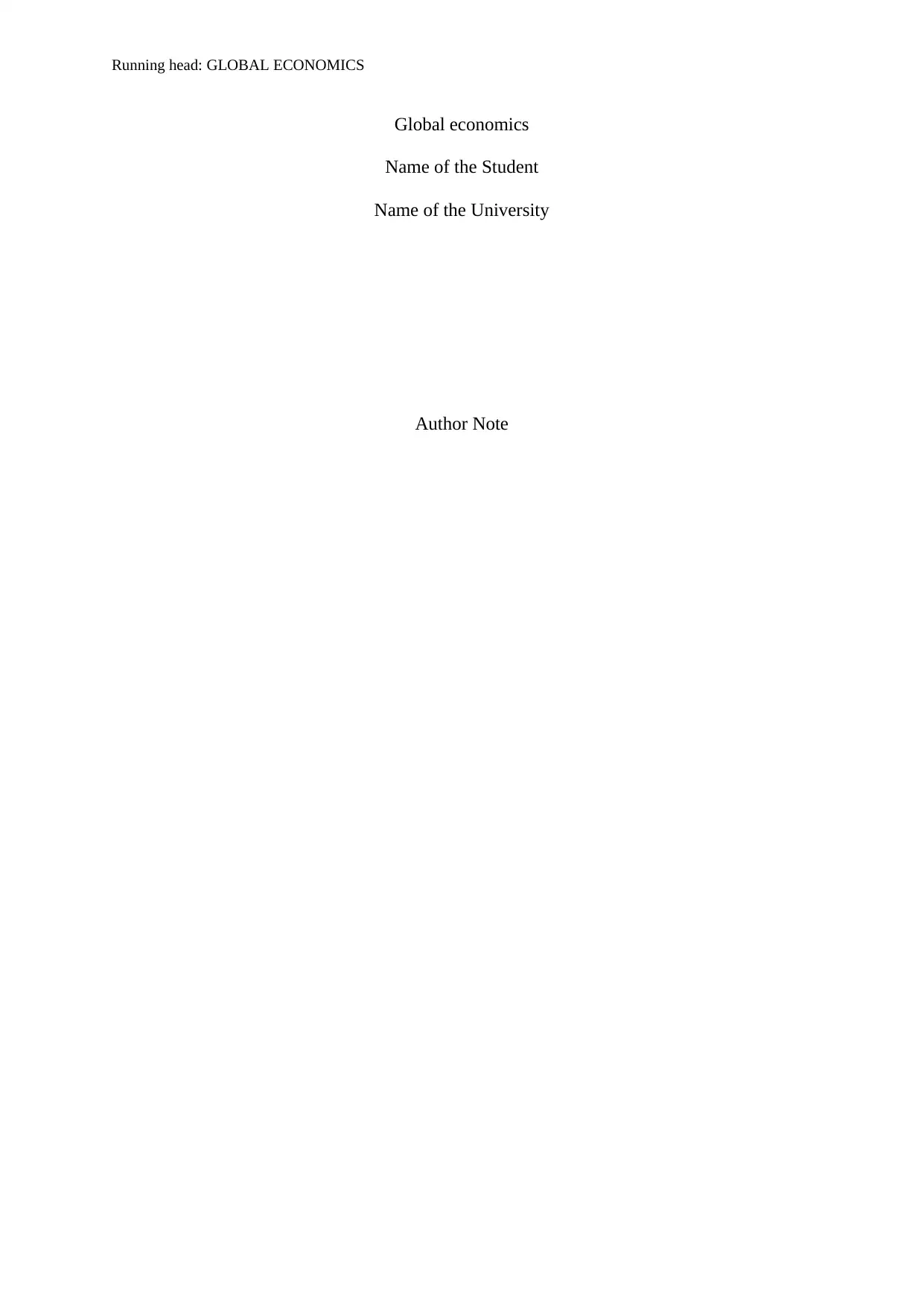
Running head: GLOBAL ECONOMICS
Global economics
Name of the Student
Name of the University
Author Note
Global economics
Name of the Student
Name of the University
Author Note
Paraphrase This Document
Need a fresh take? Get an instant paraphrase of this document with our AI Paraphraser
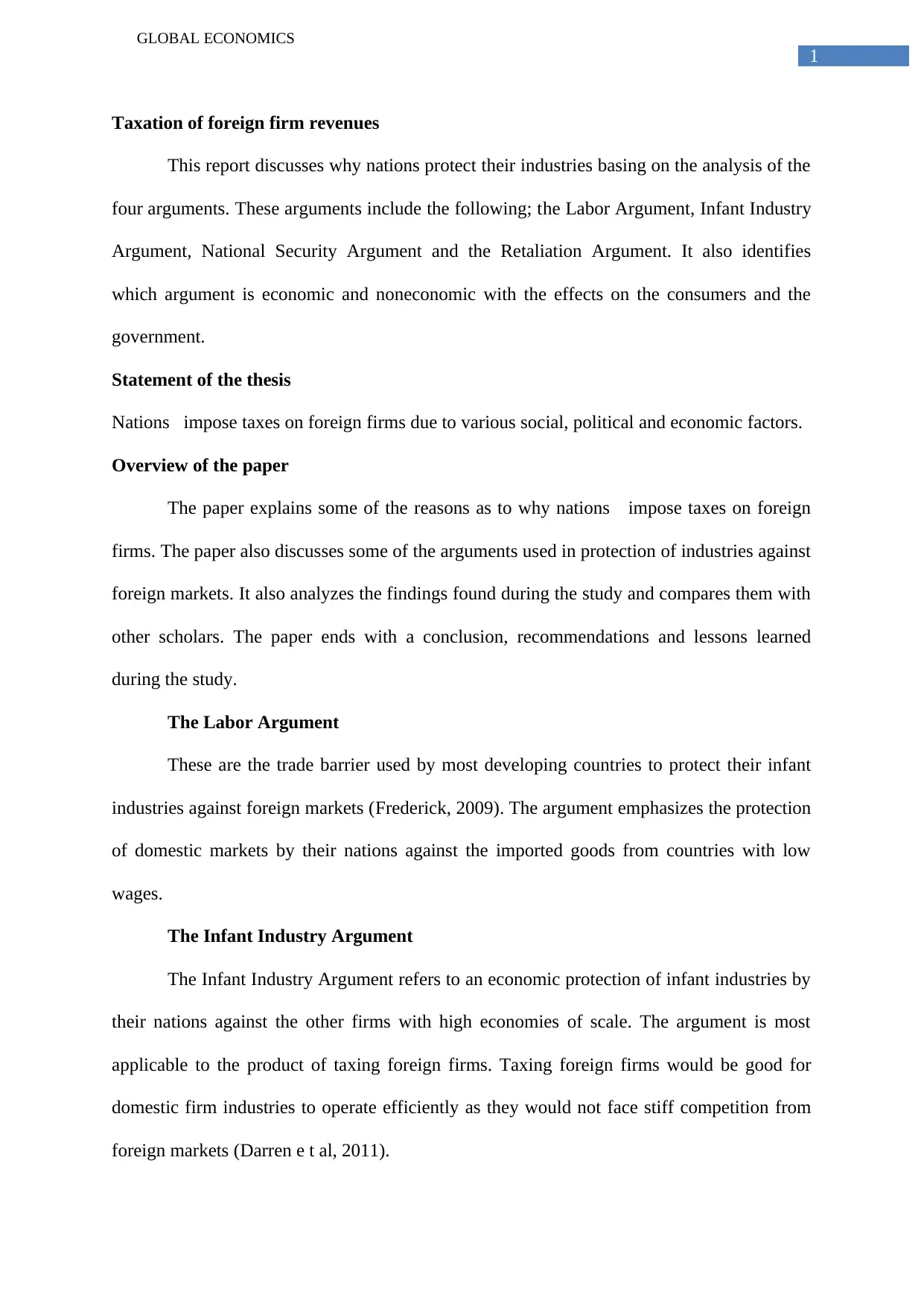
1
GLOBAL ECONOMICS
Taxation of foreign firm revenues
This report discusses why nations protect their industries basing on the analysis of the
four arguments. These arguments include the following; the Labor Argument, Infant Industry
Argument, National Security Argument and the Retaliation Argument. It also identifies
which argument is economic and noneconomic with the effects on the consumers and the
government.
Statement of the thesis
Nations impose taxes on foreign firms due to various social, political and economic factors.
Overview of the paper
The paper explains some of the reasons as to why nations impose taxes on foreign
firms. The paper also discusses some of the arguments used in protection of industries against
foreign markets. It also analyzes the findings found during the study and compares them with
other scholars. The paper ends with a conclusion, recommendations and lessons learned
during the study.
The Labor Argument
These are the trade barrier used by most developing countries to protect their infant
industries against foreign markets (Frederick, 2009). The argument emphasizes the protection
of domestic markets by their nations against the imported goods from countries with low
wages.
The Infant Industry Argument
The Infant Industry Argument refers to an economic protection of infant industries by
their nations against the other firms with high economies of scale. The argument is most
applicable to the product of taxing foreign firms. Taxing foreign firms would be good for
domestic firm industries to operate efficiently as they would not face stiff competition from
foreign markets (Darren e t al, 2011).
GLOBAL ECONOMICS
Taxation of foreign firm revenues
This report discusses why nations protect their industries basing on the analysis of the
four arguments. These arguments include the following; the Labor Argument, Infant Industry
Argument, National Security Argument and the Retaliation Argument. It also identifies
which argument is economic and noneconomic with the effects on the consumers and the
government.
Statement of the thesis
Nations impose taxes on foreign firms due to various social, political and economic factors.
Overview of the paper
The paper explains some of the reasons as to why nations impose taxes on foreign
firms. The paper also discusses some of the arguments used in protection of industries against
foreign markets. It also analyzes the findings found during the study and compares them with
other scholars. The paper ends with a conclusion, recommendations and lessons learned
during the study.
The Labor Argument
These are the trade barrier used by most developing countries to protect their infant
industries against foreign markets (Frederick, 2009). The argument emphasizes the protection
of domestic markets by their nations against the imported goods from countries with low
wages.
The Infant Industry Argument
The Infant Industry Argument refers to an economic protection of infant industries by
their nations against the other firms with high economies of scale. The argument is most
applicable to the product of taxing foreign firms. Taxing foreign firms would be good for
domestic firm industries to operate efficiently as they would not face stiff competition from
foreign markets (Darren e t al, 2011).
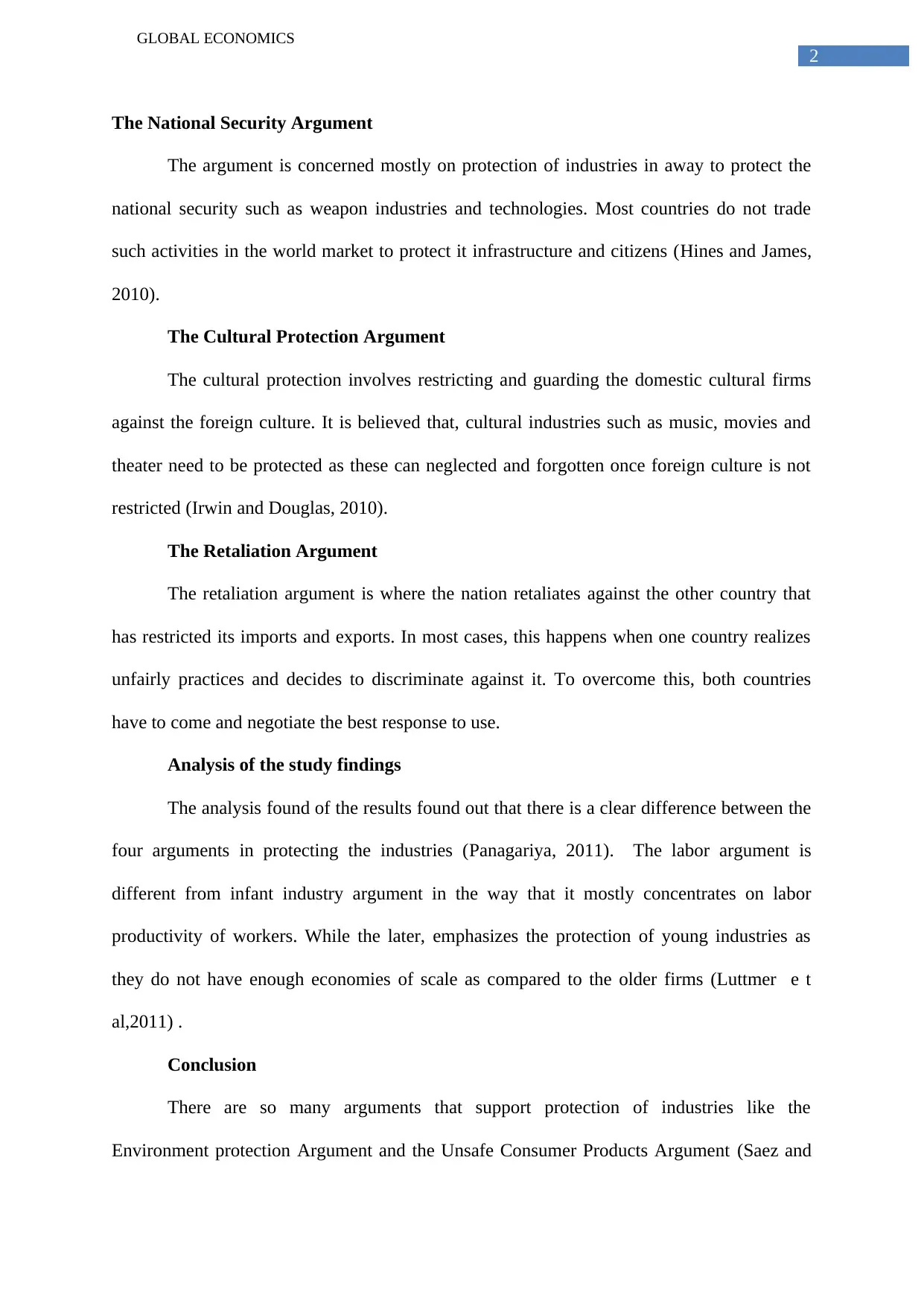
2
GLOBAL ECONOMICS
The National Security Argument
The argument is concerned mostly on protection of industries in away to protect the
national security such as weapon industries and technologies. Most countries do not trade
such activities in the world market to protect it infrastructure and citizens (Hines and James,
2010).
The Cultural Protection Argument
The cultural protection involves restricting and guarding the domestic cultural firms
against the foreign culture. It is believed that, cultural industries such as music, movies and
theater need to be protected as these can neglected and forgotten once foreign culture is not
restricted (Irwin and Douglas, 2010).
The Retaliation Argument
The retaliation argument is where the nation retaliates against the other country that
has restricted its imports and exports. In most cases, this happens when one country realizes
unfairly practices and decides to discriminate against it. To overcome this, both countries
have to come and negotiate the best response to use.
Analysis of the study findings
The analysis found of the results found out that there is a clear difference between the
four arguments in protecting the industries (Panagariya, 2011). The labor argument is
different from infant industry argument in the way that it mostly concentrates on labor
productivity of workers. While the later, emphasizes the protection of young industries as
they do not have enough economies of scale as compared to the older firms (Luttmer e t
al,2011) .
Conclusion
There are so many arguments that support protection of industries like the
Environment protection Argument and the Unsafe Consumer Products Argument (Saez and
GLOBAL ECONOMICS
The National Security Argument
The argument is concerned mostly on protection of industries in away to protect the
national security such as weapon industries and technologies. Most countries do not trade
such activities in the world market to protect it infrastructure and citizens (Hines and James,
2010).
The Cultural Protection Argument
The cultural protection involves restricting and guarding the domestic cultural firms
against the foreign culture. It is believed that, cultural industries such as music, movies and
theater need to be protected as these can neglected and forgotten once foreign culture is not
restricted (Irwin and Douglas, 2010).
The Retaliation Argument
The retaliation argument is where the nation retaliates against the other country that
has restricted its imports and exports. In most cases, this happens when one country realizes
unfairly practices and decides to discriminate against it. To overcome this, both countries
have to come and negotiate the best response to use.
Analysis of the study findings
The analysis found of the results found out that there is a clear difference between the
four arguments in protecting the industries (Panagariya, 2011). The labor argument is
different from infant industry argument in the way that it mostly concentrates on labor
productivity of workers. While the later, emphasizes the protection of young industries as
they do not have enough economies of scale as compared to the older firms (Luttmer e t
al,2011) .
Conclusion
There are so many arguments that support protection of industries like the
Environment protection Argument and the Unsafe Consumer Products Argument (Saez and
⊘ This is a preview!⊘
Do you want full access?
Subscribe today to unlock all pages.

Trusted by 1+ million students worldwide

3
GLOBAL ECONOMICS
Emmanuel, 2010). In most cases they are industry based on environmental concerns,
competition and security. Most developing countries use the infant industry argument to be
more efficient in protecting their young industries. Finally, protection for industries isn good
and countries should always select the most appropriate argument to use.
Lessons learned and recommendations
The researcher learnt some new things like new arguments for industry protection
such as the Environment Protection Argument. New skills of research about industry
protection were acquired by the researcher. Finally, the researcher would recommend that all
nations should protect their infant industries so as boast domestic production.
Quantitative Analysis
The graph below shows the supply and demand for a good that is both domestically produced
and imported.
The figure shows the supply (S) and demand (D) curve for a good which is produced
domestically and imported. The supply curve is the at price Pw which is the horizontal line.
Supposing the producers are willing to supply Q1 then the domestic demand is Q2. The
difference between the supply and the demand as Q1-Q2 will be the imports (Panagariya,
2011).
The effects of a tariff of a small country on the world prices
Q2*
price
Quantity
S
D
Pw
Pt
Q1 Q1* Q2
GLOBAL ECONOMICS
Emmanuel, 2010). In most cases they are industry based on environmental concerns,
competition and security. Most developing countries use the infant industry argument to be
more efficient in protecting their young industries. Finally, protection for industries isn good
and countries should always select the most appropriate argument to use.
Lessons learned and recommendations
The researcher learnt some new things like new arguments for industry protection
such as the Environment Protection Argument. New skills of research about industry
protection were acquired by the researcher. Finally, the researcher would recommend that all
nations should protect their infant industries so as boast domestic production.
Quantitative Analysis
The graph below shows the supply and demand for a good that is both domestically produced
and imported.
The figure shows the supply (S) and demand (D) curve for a good which is produced
domestically and imported. The supply curve is the at price Pw which is the horizontal line.
Supposing the producers are willing to supply Q1 then the domestic demand is Q2. The
difference between the supply and the demand as Q1-Q2 will be the imports (Panagariya,
2011).
The effects of a tariff of a small country on the world prices
Q2*
price
Quantity
S
D
Pw
Pt
Q1 Q1* Q2
Paraphrase This Document
Need a fresh take? Get an instant paraphrase of this document with our AI Paraphraser
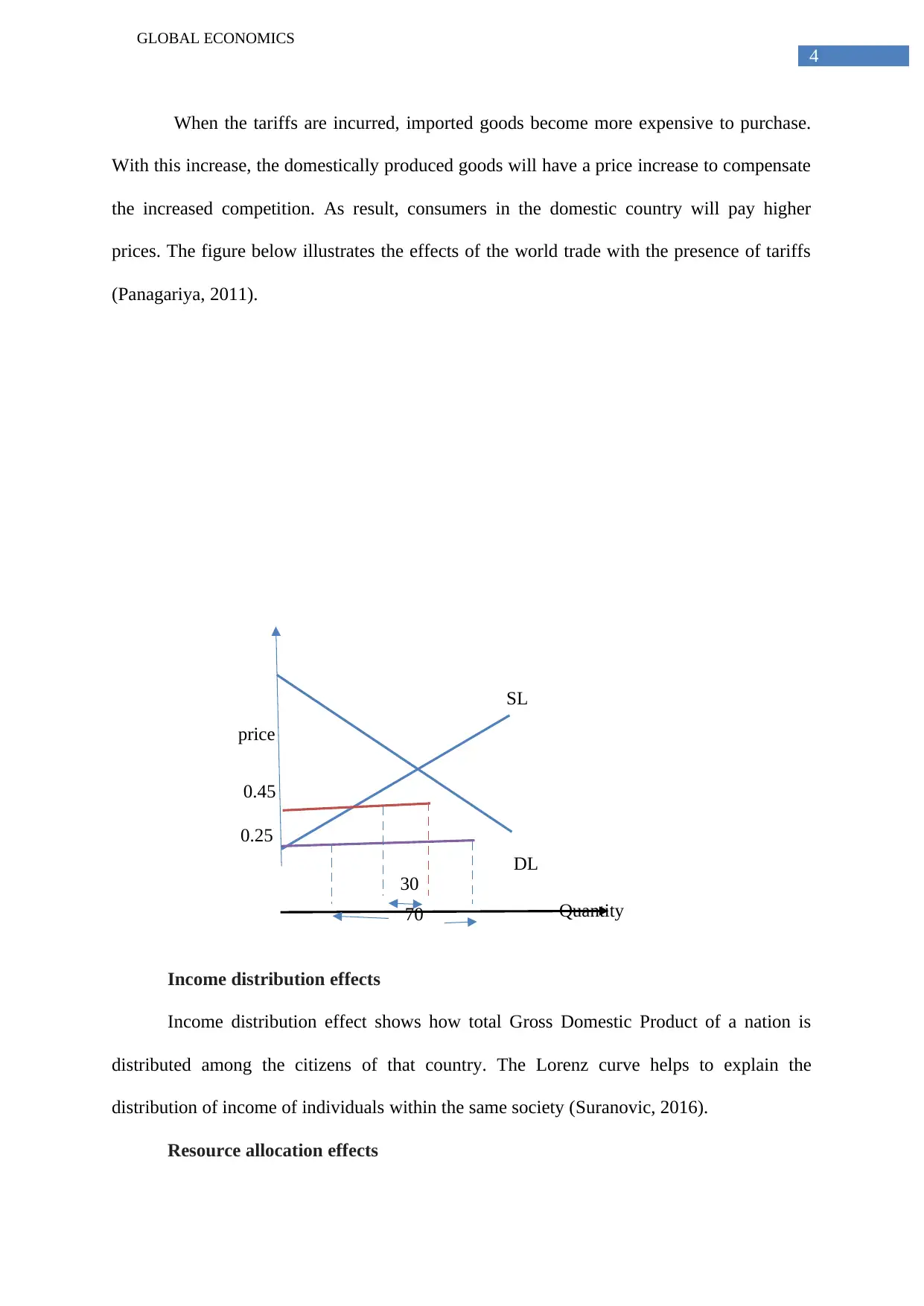
4
GLOBAL ECONOMICS
When the tariffs are incurred, imported goods become more expensive to purchase.
With this increase, the domestically produced goods will have a price increase to compensate
the increased competition. As result, consumers in the domestic country will pay higher
prices. The figure below illustrates the effects of the world trade with the presence of tariffs
(Panagariya, 2011).
Income distribution effects
Income distribution effect shows how total Gross Domestic Product of a nation is
distributed among the citizens of that country. The Lorenz curve helps to explain the
distribution of income of individuals within the same society (Suranovic, 2016).
Resource allocation effects
price
Quantity
SL
DL
0.25
0.45
30
70
GLOBAL ECONOMICS
When the tariffs are incurred, imported goods become more expensive to purchase.
With this increase, the domestically produced goods will have a price increase to compensate
the increased competition. As result, consumers in the domestic country will pay higher
prices. The figure below illustrates the effects of the world trade with the presence of tariffs
(Panagariya, 2011).
Income distribution effects
Income distribution effect shows how total Gross Domestic Product of a nation is
distributed among the citizens of that country. The Lorenz curve helps to explain the
distribution of income of individuals within the same society (Suranovic, 2016).
Resource allocation effects
price
Quantity
SL
DL
0.25
0.45
30
70
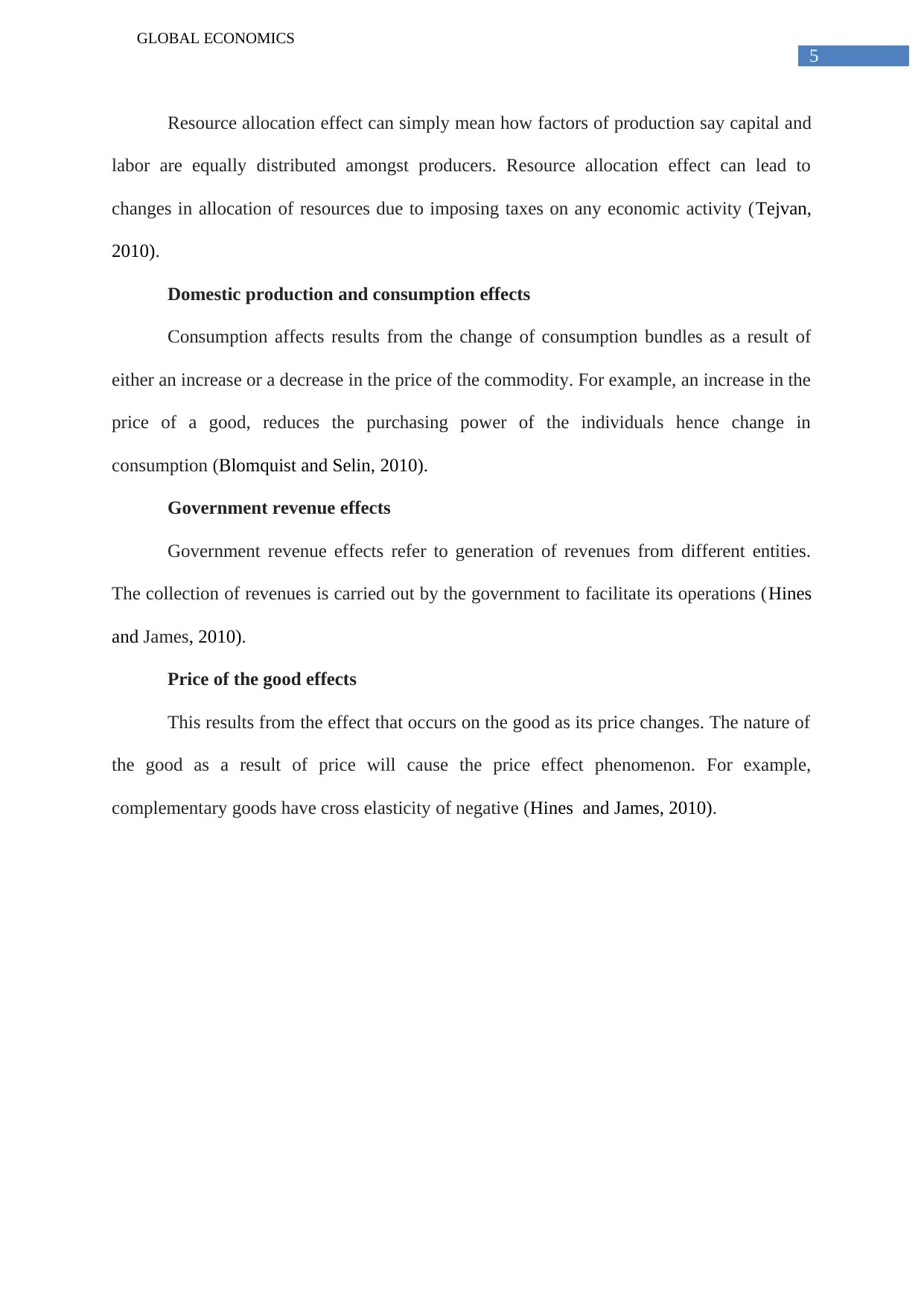
5
GLOBAL ECONOMICS
Resource allocation effect can simply mean how factors of production say capital and
labor are equally distributed amongst producers. Resource allocation effect can lead to
changes in allocation of resources due to imposing taxes on any economic activity (Tejvan,
2010).
Domestic production and consumption effects
Consumption affects results from the change of consumption bundles as a result of
either an increase or a decrease in the price of the commodity. For example, an increase in the
price of a good, reduces the purchasing power of the individuals hence change in
consumption (Blomquist and Selin, 2010).
Government revenue effects
Government revenue effects refer to generation of revenues from different entities.
The collection of revenues is carried out by the government to facilitate its operations (Hines
and James, 2010).
Price of the good effects
This results from the effect that occurs on the good as its price changes. The nature of
the good as a result of price will cause the price effect phenomenon. For example,
complementary goods have cross elasticity of negative (Hines and James, 2010).
GLOBAL ECONOMICS
Resource allocation effect can simply mean how factors of production say capital and
labor are equally distributed amongst producers. Resource allocation effect can lead to
changes in allocation of resources due to imposing taxes on any economic activity (Tejvan,
2010).
Domestic production and consumption effects
Consumption affects results from the change of consumption bundles as a result of
either an increase or a decrease in the price of the commodity. For example, an increase in the
price of a good, reduces the purchasing power of the individuals hence change in
consumption (Blomquist and Selin, 2010).
Government revenue effects
Government revenue effects refer to generation of revenues from different entities.
The collection of revenues is carried out by the government to facilitate its operations (Hines
and James, 2010).
Price of the good effects
This results from the effect that occurs on the good as its price changes. The nature of
the good as a result of price will cause the price effect phenomenon. For example,
complementary goods have cross elasticity of negative (Hines and James, 2010).
⊘ This is a preview!⊘
Do you want full access?
Subscribe today to unlock all pages.

Trusted by 1+ million students worldwide
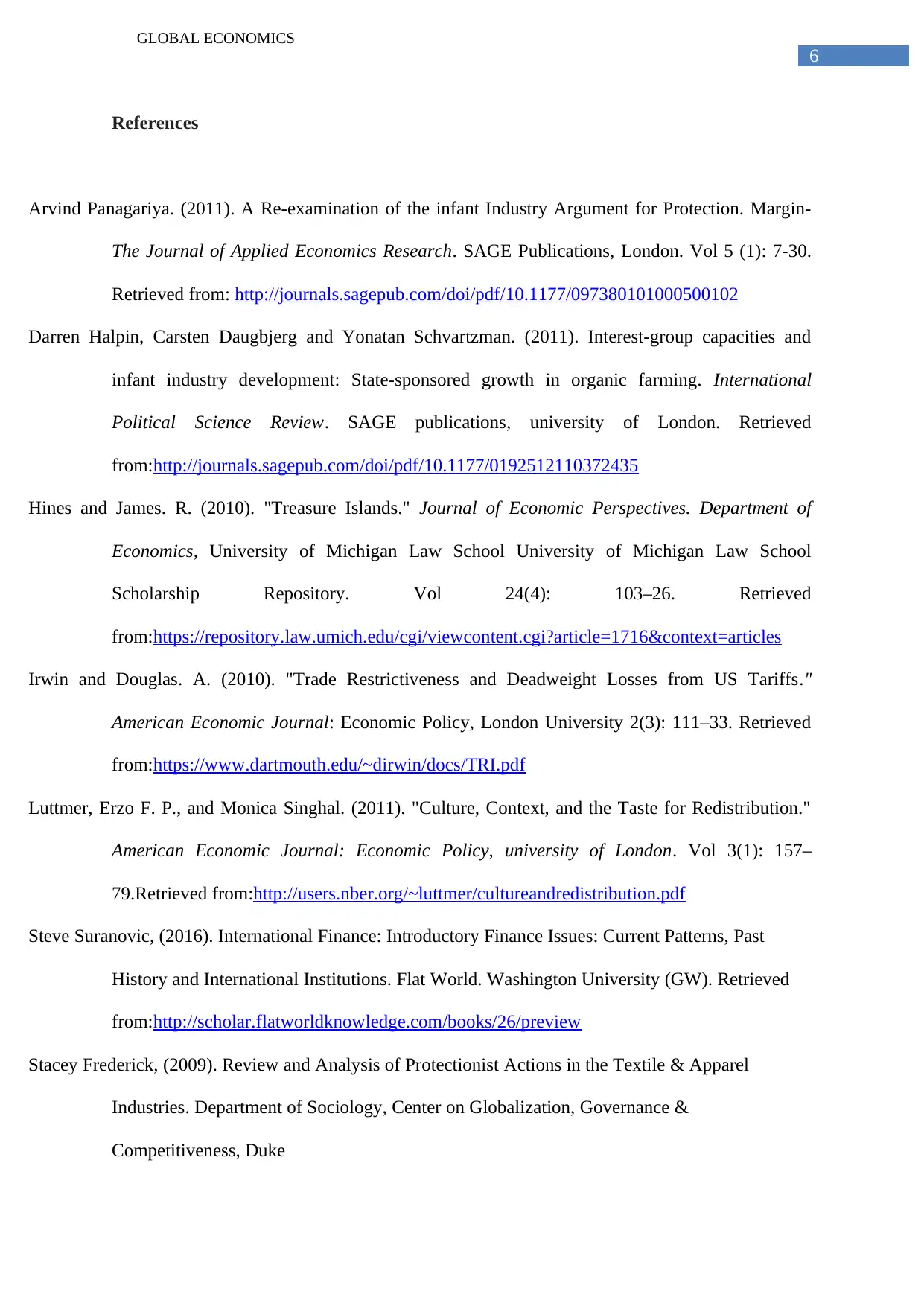
6
GLOBAL ECONOMICS
References
Arvind Panagariya. (2011). A Re-examination of the infant Industry Argument for Protection. Margin-
The Journal of Applied Economics Research. SAGE Publications, London. Vol 5 (1): 7-30.
Retrieved from: http://journals.sagepub.com/doi/pdf/10.1177/097380101000500102
Darren Halpin, Carsten Daugbjerg and Yonatan Schvartzman. (2011). Interest-group capacities and
infant industry development: State-sponsored growth in organic farming. International
Political Science Review. SAGE publications, university of London. Retrieved
from:http://journals.sagepub.com/doi/pdf/10.1177/0192512110372435
Hines and James. R. (2010). "Treasure Islands." Journal of Economic Perspectives. Department of
Economics, University of Michigan Law School University of Michigan Law School
Scholarship Repository. Vol 24(4): 103–26. Retrieved
from:https://repository.law.umich.edu/cgi/viewcontent.cgi?article=1716&context=articles
Irwin and Douglas. A. (2010). "Trade Restrictiveness and Deadweight Losses from US Tariffs."
American Economic Journal: Economic Policy, London University 2(3): 111–33. Retrieved
from:https://www.dartmouth.edu/~dirwin/docs/TRI.pdf
Luttmer, Erzo F. P., and Monica Singhal. (2011). "Culture, Context, and the Taste for Redistribution."
American Economic Journal: Economic Policy, university of London. Vol 3(1): 157–
79.Retrieved from:http://users.nber.org/~luttmer/cultureandredistribution.pdf
Steve Suranovic, (2016). International Finance: Introductory Finance Issues: Current Patterns, Past
History and International Institutions. Flat World. Washington University (GW). Retrieved
from:http://scholar.flatworldknowledge.com/books/26/preview
Stacey Frederick, (2009). Review and Analysis of Protectionist Actions in the Textile & Apparel
Industries. Department of Sociology, Center on Globalization, Governance &
Competitiveness, Duke
GLOBAL ECONOMICS
References
Arvind Panagariya. (2011). A Re-examination of the infant Industry Argument for Protection. Margin-
The Journal of Applied Economics Research. SAGE Publications, London. Vol 5 (1): 7-30.
Retrieved from: http://journals.sagepub.com/doi/pdf/10.1177/097380101000500102
Darren Halpin, Carsten Daugbjerg and Yonatan Schvartzman. (2011). Interest-group capacities and
infant industry development: State-sponsored growth in organic farming. International
Political Science Review. SAGE publications, university of London. Retrieved
from:http://journals.sagepub.com/doi/pdf/10.1177/0192512110372435
Hines and James. R. (2010). "Treasure Islands." Journal of Economic Perspectives. Department of
Economics, University of Michigan Law School University of Michigan Law School
Scholarship Repository. Vol 24(4): 103–26. Retrieved
from:https://repository.law.umich.edu/cgi/viewcontent.cgi?article=1716&context=articles
Irwin and Douglas. A. (2010). "Trade Restrictiveness and Deadweight Losses from US Tariffs."
American Economic Journal: Economic Policy, London University 2(3): 111–33. Retrieved
from:https://www.dartmouth.edu/~dirwin/docs/TRI.pdf
Luttmer, Erzo F. P., and Monica Singhal. (2011). "Culture, Context, and the Taste for Redistribution."
American Economic Journal: Economic Policy, university of London. Vol 3(1): 157–
79.Retrieved from:http://users.nber.org/~luttmer/cultureandredistribution.pdf
Steve Suranovic, (2016). International Finance: Introductory Finance Issues: Current Patterns, Past
History and International Institutions. Flat World. Washington University (GW). Retrieved
from:http://scholar.flatworldknowledge.com/books/26/preview
Stacey Frederick, (2009). Review and Analysis of Protectionist Actions in the Textile & Apparel
Industries. Department of Sociology, Center on Globalization, Governance &
Competitiveness, Duke
Paraphrase This Document
Need a fresh take? Get an instant paraphrase of this document with our AI Paraphraser
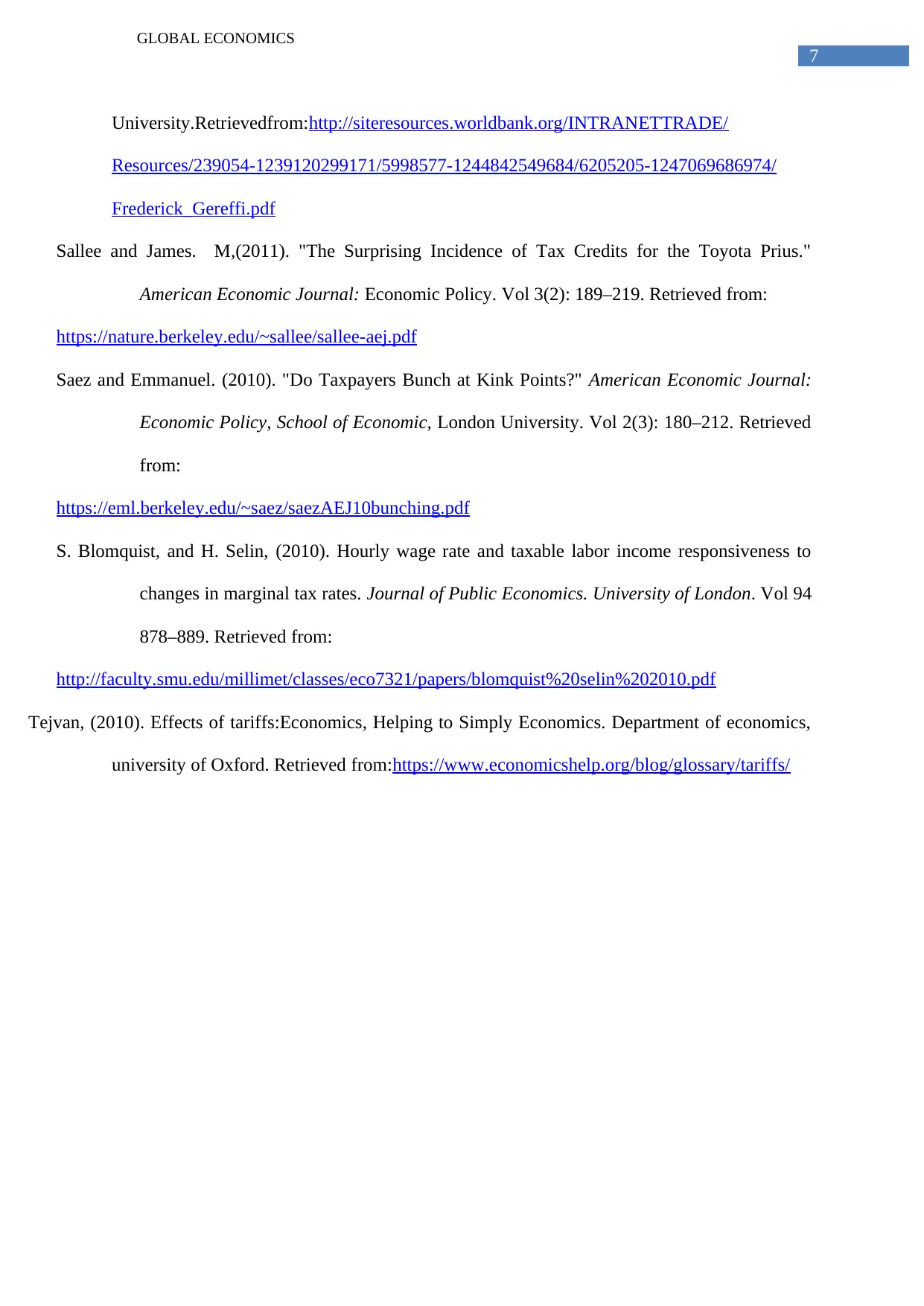
7
GLOBAL ECONOMICS
University.Retrievedfrom:http://siteresources.worldbank.org/INTRANETTRADE/
Resources/239054-1239120299171/5998577-1244842549684/6205205-1247069686974/
Frederick_Gereffi.pdf
Sallee and James. M,(2011). "The Surprising Incidence of Tax Credits for the Toyota Prius."
American Economic Journal: Economic Policy. Vol 3(2): 189–219. Retrieved from:
https://nature.berkeley.edu/~sallee/sallee-aej.pdf
Saez and Emmanuel. (2010). "Do Taxpayers Bunch at Kink Points?" American Economic Journal:
Economic Policy, School of Economic, London University. Vol 2(3): 180–212. Retrieved
from:
https://eml.berkeley.edu/~saez/saezAEJ10bunching.pdf
S. Blomquist, and H. Selin, (2010). Hourly wage rate and taxable labor income responsiveness to
changes in marginal tax rates. Journal of Public Economics. University of London. Vol 94
878–889. Retrieved from:
http://faculty.smu.edu/millimet/classes/eco7321/papers/blomquist%20selin%202010.pdf
Tejvan, (2010). Effects of tariffs:Economics, Helping to Simply Economics. Department of economics,
university of Oxford. Retrieved from:https://www.economicshelp.org/blog/glossary/tariffs/
GLOBAL ECONOMICS
University.Retrievedfrom:http://siteresources.worldbank.org/INTRANETTRADE/
Resources/239054-1239120299171/5998577-1244842549684/6205205-1247069686974/
Frederick_Gereffi.pdf
Sallee and James. M,(2011). "The Surprising Incidence of Tax Credits for the Toyota Prius."
American Economic Journal: Economic Policy. Vol 3(2): 189–219. Retrieved from:
https://nature.berkeley.edu/~sallee/sallee-aej.pdf
Saez and Emmanuel. (2010). "Do Taxpayers Bunch at Kink Points?" American Economic Journal:
Economic Policy, School of Economic, London University. Vol 2(3): 180–212. Retrieved
from:
https://eml.berkeley.edu/~saez/saezAEJ10bunching.pdf
S. Blomquist, and H. Selin, (2010). Hourly wage rate and taxable labor income responsiveness to
changes in marginal tax rates. Journal of Public Economics. University of London. Vol 94
878–889. Retrieved from:
http://faculty.smu.edu/millimet/classes/eco7321/papers/blomquist%20selin%202010.pdf
Tejvan, (2010). Effects of tariffs:Economics, Helping to Simply Economics. Department of economics,
university of Oxford. Retrieved from:https://www.economicshelp.org/blog/glossary/tariffs/
1 out of 8
Related Documents
Your All-in-One AI-Powered Toolkit for Academic Success.
+13062052269
info@desklib.com
Available 24*7 on WhatsApp / Email
![[object Object]](/_next/static/media/star-bottom.7253800d.svg)
Unlock your academic potential
Copyright © 2020–2025 A2Z Services. All Rights Reserved. Developed and managed by ZUCOL.



